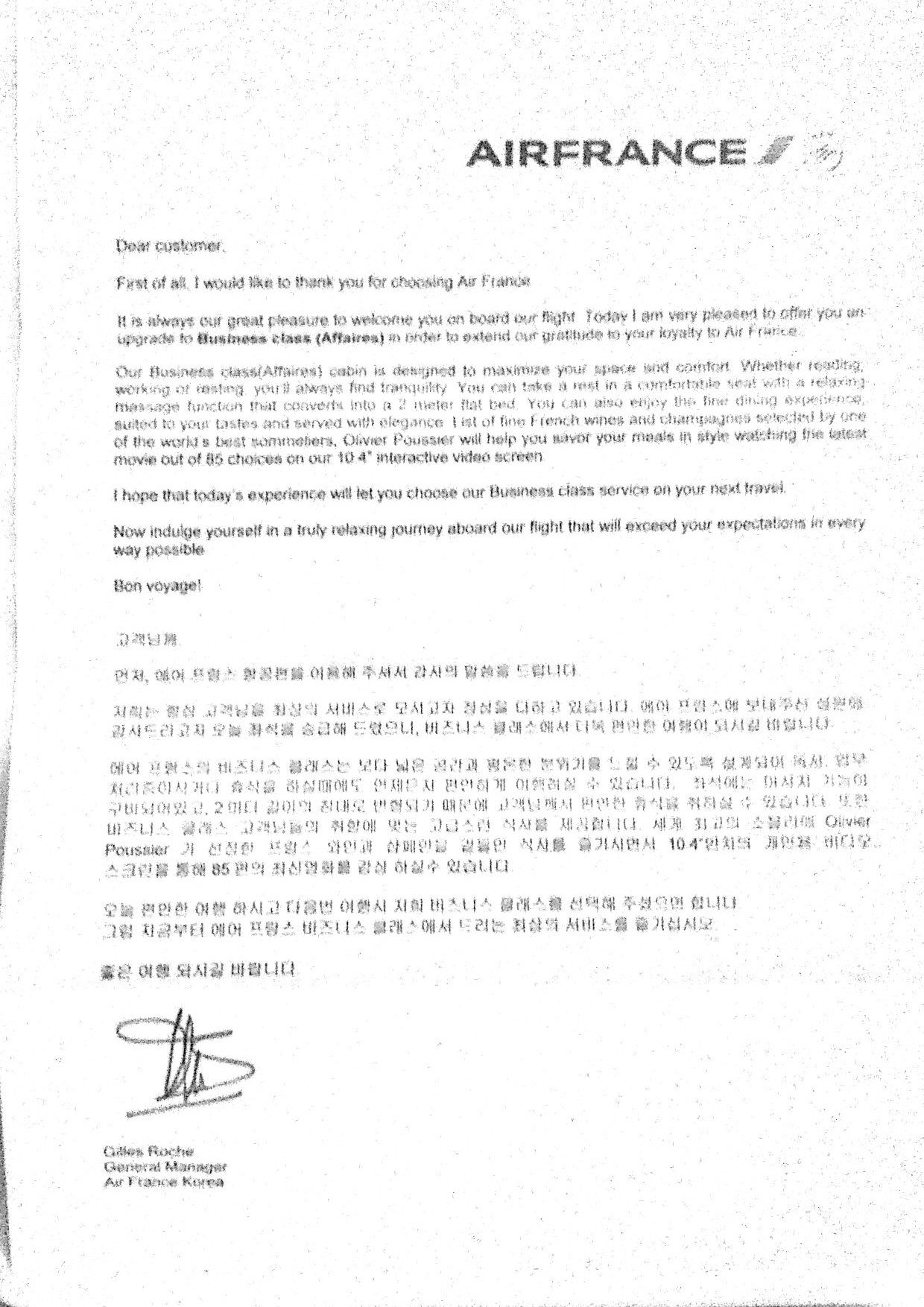Getting personal
Marketers and corporations are just going to have to get comfortable with the personal side. To the extent that clients are looking for any excuse not to buy the more expensive proposition, brands need to give and prove their value. There are many ways to create a personalized – if not personal – experience for the  customer. Not that I believe that every customer deserves to be hand held; far from it. But, the way to loyalty is to feel that you are being personally taken care of. An example: On a recent trip, I was awarded an upgrade on an Air France flight. I was, needless to say, thrilled. But, they missed a beat. Along with the new boarding pass, I was given a letter, “signed” by the General Manager (of Air France, Korea). I was quite impressed. But, upon opening, the shame was that this letter was just a form letter. I wonder how hard it would have been to create a letter personally addressed to me, instead of “Dear Customer.” Ok, time is limited before boarding, etc., but with a little adjustment to the database (and a link into the CRM system), it would be the little plus that shows an even greater level of detail and personalization. [As an aside, the English letter had a number of typos and grammatical mistakes!]. The devil is in the details, especially in the luxury market. Click to tweet this
customer. Not that I believe that every customer deserves to be hand held; far from it. But, the way to loyalty is to feel that you are being personally taken care of. An example: On a recent trip, I was awarded an upgrade on an Air France flight. I was, needless to say, thrilled. But, they missed a beat. Along with the new boarding pass, I was given a letter, “signed” by the General Manager (of Air France, Korea). I was quite impressed. But, upon opening, the shame was that this letter was just a form letter. I wonder how hard it would have been to create a letter personally addressed to me, instead of “Dear Customer.” Ok, time is limited before boarding, etc., but with a little adjustment to the database (and a link into the CRM system), it would be the little plus that shows an even greater level of detail and personalization. [As an aside, the English letter had a number of typos and grammatical mistakes!]. The devil is in the details, especially in the luxury market. Click to tweet this
Digital marketing & the scope of personality
As brands continue to adopt digital marketing and social media strategies, the big question mark remains as to how the corporate culture – as incarnated by the resident chief(s) – will impact the scope and depth of engagement. [Here is how NOT to do it: by Sarkozy and Hollande]. Organizations that desire to be customer centric will need to rewire their operations, flatten hierarchy and reveal their human qualities. Being able to put yourself in your customer’s shoes, means a very healthy dose of empathy. Or, per Steve Jobs, an obsession with the user experience. And, operating in real time puts pressure on organizations to be “on” virtually all the time.
Creating a powerful digital marketing campaign will mean understanding the mindset of your customer along the consumer journey. Moreover, in the B2C world, the consumption of the goods and services and the communication with them needs to happen on their time, which is often during their personal downtime. Here are a few points that may bring the issue home to roost.
NEWS FLASH! Customers consume digital for personal purposes mostly away from work
As brands move to digital marketing and social media marketing, in particular, organizations will have to be prepared to monitor, post, engage with and respond to their customers in the evenings and on weekends. As far as buying online (eCommerce) or customer service is concerned, for the vast majority of us, the only time we have to get caught up on personal stuff is on our own time. The million dollar question: is your organization geared up to respond?
Real Time
 If engagement is to occur online, teams must be given the license (with training and parameters) by which to interact quickly. [If you agree, tweet this!] Protocol and red tape not only slow down response time, they make for staid and superficial communications.
If engagement is to occur online, teams must be given the license (with training and parameters) by which to interact quickly. [If you agree, tweet this!] Protocol and red tape not only slow down response time, they make for staid and superficial communications.
Talk to me when and how I want
As the mobile (i.e. smartphones and tablets) becomes omnipresent, the ability to understand the user experience becomes crucial. Especially among the more influential people, customers may well have two active mobile handsets (e.g. a work Blackberry and a personal iPhone) and one tablet. Knowing how and when to engage with that customer across all his/her devices will be critical in securing a reasonable return on investment. Each device will be configured differently and consumed in distinct ways. If the brand is not to be “unsubscribed,” brand marketers must tread carefully and “join the conversation” rather than intervene. The smartphone is a deeply personal object, completely unique to each and every one us thanks to the personal calendar, address book, photos, music collection, selection of apps, etc. The mobile interface is perhaps the epitome of why branding and marketing must get more personal.
The world is fl-at … and fl-exible?
For HR teams, one of the nightmares is figuring how to align the organization’s workflow with the consumer experience.
 With the Internet being worldwide and “always on”, companies need to review how they organize their workforce. Especially true for the internationally operating executive, with timeline differences, many employees are forced to be “always on.” Maybe the flatness of the world will be another reason to push companies to accept a more flexible work hours?
With the Internet being worldwide and “always on”, companies need to review how they organize their workforce. Especially true for the internationally operating executive, with timeline differences, many employees are forced to be “always on.” Maybe the flatness of the world will be another reason to push companies to accept a more flexible work hours?
Individuals have global scope and live and walk around locally. In order to reach people, you need global reach yet to feel local, as if you are there with them. It’s a personal voyage. And, just like the GM of Air France in Korea, he wanted to be seated beside me only “in theory.” Just one more step and he could have been!
Taking a line out of Seth Godin’s blog post “It’s not business, it’s personal” a little while back, I fully agree with this notion: “Whenever you can, work with people who take it personally.”
Please do share your thoughts!











Trackbacks/Pingbacks